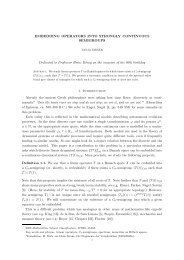Proceedings of the 13 ESSLLI Student Session - Multiple Choices ...
Proceedings of the 13 ESSLLI Student Session - Multiple Choices ...
Proceedings of the 13 ESSLLI Student Session - Multiple Choices ...
Create successful ePaper yourself
Turn your PDF publications into a flip-book with our unique Google optimized e-Paper software.
Though every element <strong>of</strong> an information state is a salient possibility (except <strong>the</strong> empty<br />
set, which is present to simplify <strong>the</strong> definition <strong>of</strong> an answer to a question), <strong>the</strong> sets in an<br />
information state do not exhaust its salient possibilities. Ra<strong>the</strong>r, <strong>the</strong> salient possibilities<br />
in an information state are generated by closing it under union and intersection. Salient<br />
possibilities are defined this way because, intuitively, if P1 and P2 are salient possibilities<br />
in a context, <strong>the</strong>n if <strong>the</strong>y are not mutually exclusive it is also possible that <strong>the</strong>y both obtain.<br />
Thus, <strong>the</strong>ir intersection should count as a salient possibility as well. Similar reasoning<br />
supports considering <strong>the</strong> union <strong>of</strong> salient possibilities to be a salient possibility.<br />
DEFINITION 3. Let Γ be an information state. Then 〈Γ〉, <strong>the</strong> set <strong>of</strong> salient possibilities in<br />
Γ, is defined as <strong>the</strong> <strong>the</strong> smallest set such that:<br />
(i) If P ∈ Γ, <strong>the</strong>n P ∈ 〈Γ〉 (ii) If P1, P2 ∈ 〈Γ〉, <strong>the</strong>n P1 ∪ P2 ∈ 〈Γ〉<br />
(iii) If P1, P2 ∈ 〈Γ〉, <strong>the</strong>n P1 ∩ P2 ∈ 〈Γ〉.<br />
We need one more concept in order to define <strong>the</strong> semantics <strong>of</strong> wh-questions. On our<br />
analysis, wh-questions introduce salient possibilities corresponding to each <strong>of</strong> <strong>the</strong>ir possible<br />
answers into an information state. To represent <strong>the</strong> possible answers to a wh-question,<br />
we use <strong>the</strong> relations defined in definition 5 (Definition 4 is a standard account <strong>of</strong> satisfaction,<br />
which is necessary for articulating definition 5):<br />
DEFINITION 4. Let φ ψ ∈ L1, let i be an index, and let g be a variable assignment function.<br />
(i) If φ = Qt1...tn, <strong>the</strong>n i |= φ [g] iff 〈[t1] i,g ,...,[tn] i,g 〉 ∈ i(Q)<br />
(ii) i |= φ ∧ ψ [g] iff i |= φ [g] and i |= ψ [g] (iii) i |= ¬φ [g] iff i �|= φ [g]<br />
DEFINITION 5. Let φ ∈ L1, and let i and j be indices. We say that i ≡ j (mod φ) if for all<br />
assignments g, i |= φ [g] iff i |= ψ [g]<br />
Given a formula φ, definition 6 defines <strong>the</strong> conditions under which two indices give<br />
<strong>the</strong> same answer to <strong>the</strong> question ?φ. For a sentence φ <strong>of</strong> L1, i ≡ j (mod φ) will hold as<br />
long as i and j assign φ <strong>the</strong> same truth value. But for a formula <strong>of</strong> L1 with free variables,<br />
congruence modulo φ requires that <strong>the</strong> indices assign <strong>the</strong> same denotations (or just similar<br />
denotations if <strong>the</strong> formula contains both free variables and constants) to predicates that<br />
occur in φ. The following examples illustrates how this definition works.<br />
EXAMPLE 1.<br />
<strong>Proceedings</strong> <strong>of</strong> <strong>the</strong> <strong>13</strong> th <strong>ESSLLI</strong> <strong>Student</strong> <strong>Session</strong><br />
(i) Let ?φ = ?Px (Who came to <strong>the</strong> party?) i ≡ j (mod φ) if i(P) = j(P), or informally, if <strong>the</strong><br />
same people came to <strong>the</strong> party according to indices i and j.<br />
(ii) Let ?φ = ?Ibx (Who did Bill invite to <strong>the</strong> party?) i ≡ j (mod φ) if<br />
{d ∈ D| 〈d, i(b)〉 ∈ i(P)} = {d ∈ D| 〈d, j(b)〉 ∈ j(P)}.<br />
(iii) Let ?φ = ?p (Did Alice help Bill?) i ≡ j (mod φ) if i |= p iff j |= p.<br />
In our update semantics, <strong>the</strong> effect <strong>of</strong> a formula on an information state will be defined<br />
in terms <strong>of</strong> <strong>the</strong> effects it has on certain elements <strong>of</strong> <strong>the</strong> information state. Thus, to state<br />
our update semantics for information states we require an update semantics for sets <strong>of</strong><br />
indices as well. The update semantics for sets indices is fairly simple, and is roughly <strong>the</strong><br />
same as that given in Veltman (1996).<br />
DEFINITION 6. Let φ ∈ L1 ∪ L2 be a sentence, and let P be a set <strong>of</strong> indices. We define <strong>the</strong><br />
update <strong>of</strong> P with φ, written P[φ], as follows:<br />
(i) P[p] = {i ∈ P | i |= p} (ii) P[φ ∧ ψ] = P[φ][ψ]<br />
(iii) P[¬φ] = {i ∈ P | i �∈ P[φ]} (iv) P[⋄φ] = P if P[φ] �= ∅<br />
(v) P[⋄φ] = ∅ if P[φ] = ∅<br />
30

















